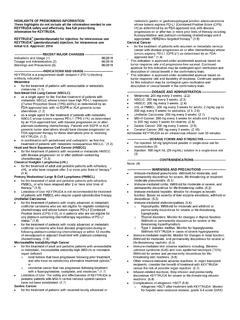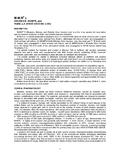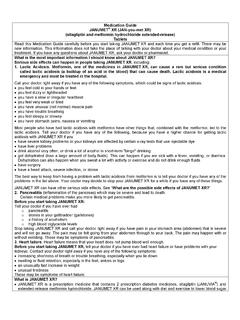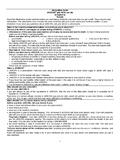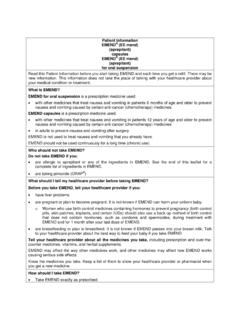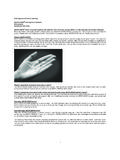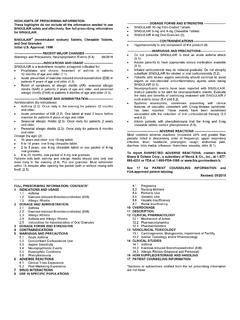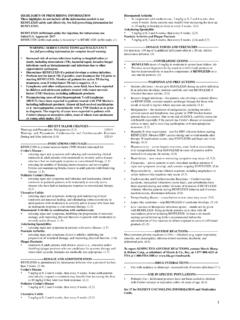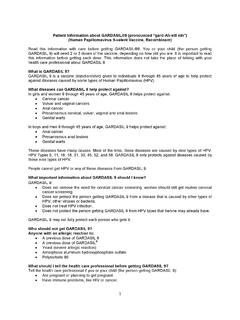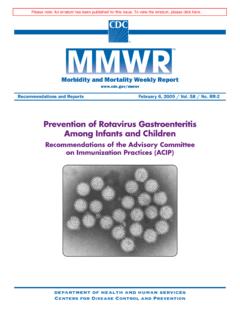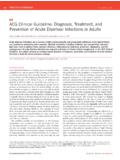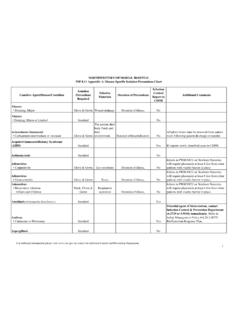Transcription of HIGHLIGHTS OF PRESCRIBING INFORMATION potentially ...
1 HIGHLIGHTS OF PRESCRIBING INFORMATIONT hese HIGHLIGHTS do not include all the INFORMATION needed to use rotateq safely and effectively. See full PRESCRIBING INFORMATION for ( rotavirus Vaccine, Live, Oral, Pentavalent)Oral SolutionInitial Approval: 2006---------------------------INDICATIO NS AND USAGE ---------------------------- rotateq is a vaccine indicated for the prevention of rotavirus gastroenteritis caused by typesG1, G2, G3, G4, and G9.(1) rotateq is approved for use in infants 6 weeks to 32 weeks of age.(1)-----------------------DOSAGE AND ADMINISTRATION------------------------ FOR ORAL USE ONLY. NOT FOR INJECTION. (2) The vaccination seriesconsists of three ready-to-use liquid doses of rotateq administeredorally starting at 6 to 12 weeks of age, with the subsequent doses administered at 4- to 10-week intervals.
2 The third dose should not be given after 32 weeks of age. (2)---------------------DOSAGE FORMS AND STRENGTHS----------------------2 mL solution for oral administrationof 5 live human-bovine reassortant rotaviruses which contains a minimum of x 106infectious units (IU) per reassortantdose, depending on the reassortant, and not greater than 116 x 106IU per aggregate dose. (3)------------------------------CONTRAI NDICATIONS------------------------------ - A demonstrated history of hypersensitivity to the vaccine or any component of the vaccine. ( ) History of Severe Combined Immunodeficiency Disease (SCID). ( , ) History of intussusception. ( )-----------------------WARNINGS AND PRECAUTIONS------------------------ No safety or efficacy data are available from clinical trials regarding the administration of rotateq to infants who are potentially immunocompromised ( , HIV/AIDS).
3 ( ) In a post-marketing study, cases of intussusception were observed in temporal association within 21 days following the first dose of rotateq , with a clustering of cases in the first 7 days.( , ) Nosafety or efficacy data are available for theadministration of rotateq to infants with a history of gastrointestinal disorders ( , active acute gastrointestinal illness, chronic diarrhea, failure to thrive, history of congenital abdominal disorders, and abdominal surgery). ( ) Vaccine virus transmission from vaccine recipient to non-vaccinated contacts has been reported. Cautionis advised when considering whether to administerRotaTeq to individuals with immunodeficient contacts. ( )------------------------------ADVERSE REACTIONS------------------------------- Most common adverse events included diarrhea, vomiting, irritability, otitis media, nasopharyngitis, and bronchospasm.
4 ( )To report SUSPECTED ADVERSE REACTIONS, contact Merck Sharp & Dohme Corp., a subsidiary of Merck & Co., Inc., at 1-877-888-4231 or VAERS at 1-800-822-7967or IN SPECIFIC POPULATIONS------------------------Pedia tric Use: Safety and efficacy have not been established in infants less than 6 weeks of age or greater than 32 weeks of age. Data are available from clinical studies to support the use ofRotaTeq in: Pre-term infants according totheir age in weeks since birth Infants with controlled gastroesophageal reflux disease. ( )See 17 for PATIENT COUNSELING INFORMATION and FDA-approved patient :03/2018 FULL PRESCRIBING INFORMATION : CONTENTS*1 INDICATIONS AND USAGE2 DOSAGE AND with Other for Use3 DOSAGE FORMS AND Combined Immunodeficiency of Intussusception5 WARNINGSAND Allergic and of Vaccine Prophylaxis6 ADVERSE Studies Experience7 DRUG Vaccine Administration8 USE IN SPECIFIC Use10 OVERDOSAGE11 DESCRIPTION12 CLINICAL of Action13 NONCLINICAL , Mutagenesis, Impairment of Fertility14 CLINICAL Efficacy and Safety Trial (Study 006)
5 gastroenteritis Regardless of gastroenteritis by SUPPLIED/STORAGE AND and Handling17 PATIENT COUNSELING INFORMATION *Sections or subsections omitted from the full PRESCRIBING INFORMATION are not PRESCRIBING INFORMATION1 INDICATIONS AND USAGERotaTeq is indicated for the prevention of rotavirus gastroenteritis in infants and children caused by typesG1, G2, G3, G4, and G9when administered as a 3-dose series to infants between the ages of 6 to 32weeks. The first dose of rotateq should be administered between 6 and 12weeks of age[see Dosage and Administration (2)].2 DOSAGE AND ADMINISTRATIONFOR ORAL USE ONLY. NOT FOR vaccination series consists of three ready-to-use liquid doses of rotateq administered orally starting at 6 to 12 weeks of age, with the subsequent doses administered at 4- to 10-week intervals.
6 The third dose should not be given after 32 weeks of age[see Clinical Studies (14)].There are no restrictions on the infant s consumption of food or liquid, including breast milk, either before or after vaccination with rotateq . Do not mix the rotateq vaccine with any other vaccines or solutions. Do not reconstitute or dilute [see Dosage and Administration( )].For storage instructions [see How Supplied/Storage and Handling ( )].Each dose is supplied in a container consisting of a squeezable plastic dosing tube with a twist-off cap, allowing for directoral administration. The dosing tube is contained in a pouch [see Dosage and Administration ( )]. with Other Vaccines In clinical trials, rotateq was administered concomitantly with other licensed pediatric vaccines [see Adverse Reactions ( ), Drug Interactions ( ), and Clinical Studies (14)].
7 For UseTo administer the vaccine:Tear open the pouch and remove the dosing the fluid from the dispensing tip by holding tube vertically and tapping the dosing tube in 2 easy the dispensing tip by screwing cap clockwiseuntil it becomes cap by turning it counterclockwise. Administer dose by gently squeezing liquid into infant's mouth toward the inner cheek untildosing tube is empty. (A residual drop may remain in the tip of the tube.) If for any reason an incomplete dose is administered ( , infant spits or regurgitates the vaccine), a replacement dose is not recommended, since such dosing was not studied in the clinical trials. The infant should continue to receive any remaining doses in the recommended the empty tube and cap in approved biological waste containers according to local FORMS AND STRENGTHSRotaTeq, 2 mL for oral use, is a ready-to-use solution of live reassortant rotaviruses, containingG1, G2, G3, G4 and P1A[8] which contains a minimum of x 106 infectious units (IU) per individual reassortant dose, depending on the reassortantand not greater than 116 x 106IU per aggregate dose is supplied in a container consisting of a squeezable plastic dosing tube with a twist-off cap, allowing for direct oral administration.
8 The dosing tube is contained in a HypersensitivityA demonstrated history of hypersensitivity to any component of the who develop symptoms suggestive of hypersensitivity after receiving a dose of rotateq should not receive further doses of Combined ImmunodeficiencyDiseaseInfants with Severe Combined Immunodeficiency Disease (SCID) should not receive rotateq . Post-marketing reports of gastroenteritis , including severe diarrhea and prolonged shedding of vaccine virus, have been reported in infants who were administered rotateq and later identified as having SCID[see Adverse Reactions ( )]. of IntussusceptionInfants with a history of intussusception should not receive AND Allergic ReactionsAppropriate medicaltreatment and supervisionmustbe available to manage possibleanaphylacticreactions following administration of the Immunocompromised PopulationsNo safety or efficacy data are available from clinical trials regarding the administration of rotateq to infants who are potentially immunocompromised including: Infants with blood dyscrasias, leukemia, lymphomas of any type, or other malignant neoplasms affecting the bone marrow or lymphatic system.
9 Infants on immunosuppressive therapy (including high-dose systemic corticosteroids). rotateq may be administered to infants who are being treated with topical corticosteroids or inhaled Infants with primary and acquired immunodeficiency states, including HIV/AIDS or other clinical manifestations of infection with human immunodeficiency viruses; cellular immune deficiencies; and hypogammaglobulinemic and dysgammaglobulinemic states. There are insufficient data from the clinical trials to support administration of rotateq to infants with indeterminate HIV status who are born to mothers with HIV/AIDS. Infants who have received a blood transfusion or blood products, including immunoglobulins within virus transmission from vaccine recipient to non-vaccinated contacts has been reported [see Warnings and Precautions ( )].
10 IntussusceptionFollowing administration of a previously licensed live rhesus rotavirusreassortantvaccine, an increased risk of intussusception was a post-marketing observational study in the US casesof intussusception were observed in temporal association within 21 days following the first dose ofRotaTeq, with a clustering of cases in the first 7 days. [See Adverse Reactions ( ).]In worldwide passive post-marketing surveillance, cases of intussusception have been reported in temporal association with rotateq . [See Adverse Reactions ( ).] Gastrointestinal IllnessNo safety or efficacy data are available for administration of rotateq to infants with a history of gastrointestinal disorders including infants with active acute gastrointestinal illness, infants with chronic diarrhea and failure to thrive, and infants with a history of congenital abdominal disorders, and abdominal surgery.
